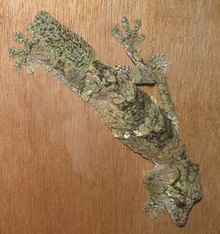Uroplatus sikorae
| Uroplatus sikorae | |
|---|---|
 |
|
| Scientific classification | |
| Kingdom: | Animalia |
| Phylum: | Chordata |
| Class: | Reptilia |
| Order: | Squamata |
| Family: | Gekkonidae |
| Genus: | Uroplatus |
| Species: | U. sikorae |
| Binomial name | |
|
Uroplatus sikorae Boettger, 1913 |
|
 |
|
| Geographic range of U. sikorae in Madagascar | |
Uroplatus sikorae is a species of gecko commonly referred to as the mossy leaf-tailed gecko. This species, endemic to Madagascar, is found in primary and secondary forests on the island. It has the ability to change its skin color to match its surroundings and possesses dermal flaps which break up its outline when at rest.
It is a CITES II protected animal due to habitat loss and overcollection for the pet trade.
The generic name, Uroplatus, is a Latinization of two Greek words: "ourá" (οὐρά) meaning "tail" and "platys" (πλατύς) meaning "flat". The specific name, sikorae, is a Latinization of the surname of Franz Sikora, an Austrian fossil-hunter and explorer of Madagascar. The species was first described by German zoologist Oskar Boettger but not published until three years after his death. Its common name refers to the mossy-like camouflage patterns and colors of the lizard's skin.
The genus Uroplatus contains 14 species endemic to Madagascar. The species Uroplatus sameiti was considered to be a subspecies of U. sikorae until 2007, when it was proposed to be elevated to species level on the basis of its pale oral mucosa, in contrast to the dark oral mucosa of U. sikorae. Subsequent publications have maintained this separate status, which has now also been verified molecularly. However, in the most recent review of the taxonomy of the Uroplatus genus, it was revealed that the different colour of the mouth is not diagnostic of these two species, as some U. sikorae species were found to share the light oral pigmentation. The diagnosis of these species based on morphology remains difficult.
...
Wikipedia

